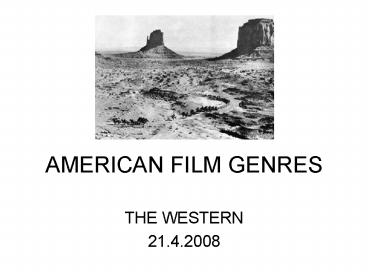AMERICAN FILM GENRES - PowerPoint PPT Presentation
1 / 16
Title:
AMERICAN FILM GENRES
Description:
Spagetti westerns: Sergio Leone. Osterns - East European westerns ... Spagetti western: Sergio Leone. Once upon a Time in the West/C'era una volta il West (1968) ... – PowerPoint PPT presentation
Number of Views:558
Avg rating:3.0/5.0
Title: AMERICAN FILM GENRES
1
AMERICAN FILM GENRES
- THE WESTERN
- 21.4.2008
2
The Western characteristics
- Time 1865-1890
- place U.S. Western Frontier, Mexico
- Monument Valley for John Ford
- characters nomadic wanderer hero, gunslinger,
townspeople, farmers and rancher, Indians, U.S.
Cavalry, damsel in distress
- Visual motifs
- Weapons revolver and rifle
- The technology of the era such as the
telegraph, printing press, and railroad - Stetson hats, bandannas, spurs, and buckskins
- the vast landscape
3
Genre evolution 3
- early formative stage
- the classical period of archetypal expression
- a more intellectual phase in which conventions
are examined and questioned rather than merely
presented - ironic, self-conscious mode typically expressed
by parody - Note these do overlap
- The Great Train Robbery, dir. Edwin S. Porter,
1903 - Stagecoach (Ford, 1939) John Fords cavalry
westerns Rio Bravo, Howard Hawks 1959 Red
River, Howard Hawks, 1948 - The Searchers, John Ford, 1956
- Robert Altman's McCabe and Mrs. Miller, Mel
Brookss Blazing Saddles (1974), Unforgiven,
Clint Eastwood. 1992
4
Edward Buscombe
- iconography - the visual conventions of Westerns
are highly distinctive and coded - but in this sense Western is a generic exception
- the Western has an imaginative relationship to
the American geography and history -gt mythology
moving western frontier where Anglo-Saxon vs.
other meet, opportunity and danger, Manifest
Destiny
5
Jim Kitses semantic analysis (1969)
- original Anthony Mann, Budd Boetticher and Sam
Peckinpah - recently revised, additions new chapters on John
Ford, Sergio Leone and Clint Eastwood - these directors found their essence in the
Western - structuralist method based on the anthropology by
Lévi-Strauss (1967) - civilisation versus the wilderness binary, around
which the binary chart is built - the collision of the structure and motifs of
melodrama where the community is seen as
invariably the endangered family in the Westerns
of Ford
6
Kitses binaries
- THE WILDERNESS
- (desert)
- The Individual
- freedom
- honor
- self-knowledge
- integiry
- self-interest
- solipsism
- CIVILIZATION
- (garden)
- The Community
- restriction
- institutions
- illusion
- compromise
- social responsibility
- democracy
7
Kitses binaries 2
- Nature
- purity
- experience
- empiricism
- pragmatism
- brutalization
- savagery
- Culture
- corruption
- knowledge
- legalism
- idealism
- refinement
- humanity
8
Kitses 3
- The West
- America
- the Frontier
- equality
- agrarianism
- tradition
- the past
- The East
- Europe
- America
- class
- industrialism
- change
- the future
9
John Cawelti (1970)
- setting on or near the frontier
- a moment in the development of Amer.
civilization law taking over lawlessness - 3 central roles the townspeople (agents of
civilization), the savages or outlaws who
threaten this group, the hero(es) who are men in
the middle - narratives w/ violent confrontations central
10
Wright
- in a classic western plot the hero uses his
savage skills to combat savagery, to thus protect
the civilized community who will finally accept
him, hero joins the community - Lévi-Strauss the hero possesses characteristics
of both sides - Die Hard, dir. John McTiernan, 1988
11
Rick Altman (1984)
- semantic analysis
- basic elements of the genre (characters,
locations, shooting style etc.) - In 1999 Altman added production (for ex genre
cycles) and audience (interpretation) into this
schemata
- syntactic approach looks at the relationships
between these elements and how they are
structured in narratives gt - thematics such as the opposition of East and
West or garden and desert (Kitses)
12
Western sub-genres
- Classical westerns Ford, Hawks
- Spagetti westerns Sergio Leone
- Osterns - East European westerns
- Revisionist western positive representation of
Native Americans, Sam Peckinpah, Unforgiven
(Clint Eastwood, 1992) - question the simple hero-versus-villain dualism
- Acid Western Mon Helmans Shooting, Jim
Jarmuschs Dead Man Walking - Contemporary western the story placed in
contemporary West Brokeback Mountain, No Country
for Old Men
13
Contemporary Western Misfits, dir. John Huston
with Marilyn Monroe and Clark Cable
14
Schatz Ritual approach
- Thomas Schatz has argued that genres can be seen
as a form of collective cultural expression and
as a vehicle for exploring ideals, cultural
values and ideas within American society. This
has led critics including Schatz to postulate
that some genres take place in different social
spaces as a symbolic arena of action such as
the cowboy or gangster film. In these films
specific social conflicts are acted out. - But ...evidence from contemporary audience
surveys suggests that westerns were produced in
large numbers during the studio era despite the
fact that they were popular only with rural
audiences and adolescent boys and despite the
fact that they were actively disliked by a
majority of the viewing population as a whole (
Steve Neale 2000 225 ) .
15
The Wild Bunch, dir. Sam Peckinpah
16
Spagetti western Sergio LeoneOnce upon a Time
in the West/C'era una volta il West (1968)
For a Fistful of Dollars












![[PDF] DOWNLOAD Dario Argento (Contemporary Film Directors) PowerPoint PPT Presentation](https://s3.amazonaws.com/images.powershow.com/10068559.th0.jpg?_=20240703121)




![READ[PDF] Victor Fleming: An American Movie Master (Screen Classics) PowerPoint PPT Presentation](https://s3.amazonaws.com/images.powershow.com/10073712.th0.jpg?_=20240705037)













